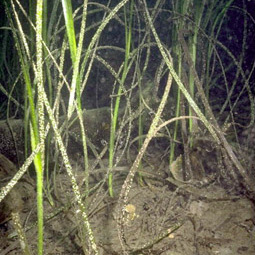Submerged marine plants; rhizome matted, orange-brown, creeping, monopodial, compressed, rooting at the nodes; erect stems annual, compressed, glabrous, the sterile stems short and arising from the axils of rhizomatous leaves, the floriferous stems terminal or lateral, sympodial, longer than the sterile stems, branched, each branch with an inflorescence. Leaves distichous, linear; leaf-sheath compressed, amplexicaul, membranous, auriculate and ligulate, persisting longer than the leaf-blades; leaf-blade linear, with 3–11 nerves and accessory bundles in between, margins entire or somewhat denticulate distally. Inflorescence terminal or lateral, forming erect annual branches, each terminating in a fertile leaf with the sheath containing a sessile, flattened, linear spadix with or without bract-like lobes (retinacula) that fold over one or more flowers. Flowers in two lines of alternating staminate and pistillate flowers on one surface of spadix; anthers single, sessile, of (1–)2(–3) locules connected by a ridge-like connective; ovary uniovulate, with persistent style, the stigmas protruding from the sheath at anthesis. Fruit membranous, cylindrical to ovoid, 1-seeded, indehiscent or irregularly dehiscent; pericarp scarious; seed ellipsoid or ovoid, smooth or ribbed; embryo grooved.
Spadix sessile, unbranched, permanently enclosed in the sheath of the uppermost If; axis flattened to a thin, membr. strap bearing ∞ fls on its concave outer face; stamens alternating with carpels in 2 longitudinal, often crowded series. Stamen of 2 pollen sacs joined by a curved connective adnate to the axis, each sac simulating a single, ovate, sessile, 1-celled anther. Carpel flask-shaped, rounded at base, attached above the middle by a cushion of tissue. Rhizome ± compressed, creeping, rooting at nodes and there producing either vegetative shoots with short internodes and long lvs or erect, short-lived, sympodial reproductive shoots with longer internodes and us. shorter lvs. Lvs ± translucent; sheath long, open or closed, ± auriculate above; lamina entire, top bluntly truncate or emarginate by erosion; primary nerves parallel, at least 3 (1 median and 2 sub-marginal), sts more; interstitial nerves more delicate, intersected at intervals by ± horizontal cross veins. Plants forming grass-like, mud-collecting swards. Cosmopolitan genus of c. 12 spp. N.Z. representatives are referred to 2 Australian spp., but the descriptions are drawn up from N.Z. plants.
Herbs, perennial or rarely annual, rooted in substrate. Roots 5--20, nodal. Leaves: sheath tubular or open, persisting longer than blade, often rupturing with age but not remaining as bundles of woolly fibers; blade entire or slightly denticulate distally; veins 3--11. Generative shoot lateral or terminal. Inflorescences: peduncle partially adnate to stem; spadix lanceolate, enclosed permanently within spathe sheath; staminate and pistillate flowers alternating on same spadix; pistillate spadix without rudimentary staminate flowers. Staminate flowers often subtended by bract. Pistillate flowers without subtending bract, pistil elliptic. Fruits achenelike, ovoid to ellipsoid.
Marine, estuarine, submerged, sometimes intertidal, monoecious, perennial rarely annual herbs. Rhizome internodes with 2 cortical vascular bundles; fibrous bundles confined to outer cortex. Roots 1 or more and leaves 2–8 per node. Erect stems absent. Leaf sheath compressed, open or closed, persisting longer than leaf blades. Leaf blade flat, entire; apex variable in shape; longitudinal veins 3–11. Generative shoots terminal or lateral. Male and female flowers arranged alternately in 2 longitudinal rows. Retinacules present or absent. Fruit ovoid or ellipsoid with scarious pericarp. Seed ellipsoid or ovoid, smooth, ribbed or ridged.
Rhizome monopodial, with 2 vascular bundles in cortex. Shoots short, with several leaves; flowering stems usually elongated, with several spathes. Leaves linear, with 3-11 parallel veins, margin entire or rarely minutely denticulate; sheaths membranous or subleathery, with an auricle, ligulate. Spadix axillary, sessile, axis flattened, without or only with inconspicuous projections (retinacula). Plants monoecious; flowers unisexual, small. Anthers 2-celled. Style short; stigmas 2, filiform or subulate. Fruit ovoid, with a short beak.
Monoecious, the staminate and pistillate fls typically alternating in each row on the spadix, which is largely hidden at anthesis in the slender, open, sheathing spathe; anthers deciduous, discharged from the spathe at anthesis; stigmas elongate, bristle-like, exserted from the spathe, deciduous; fr oblong-ovoid, the thin wall eventually rupturing irregularly; lvs elongate, ribbon-like; spathe with a deciduous blade. 10+, cosmop.

